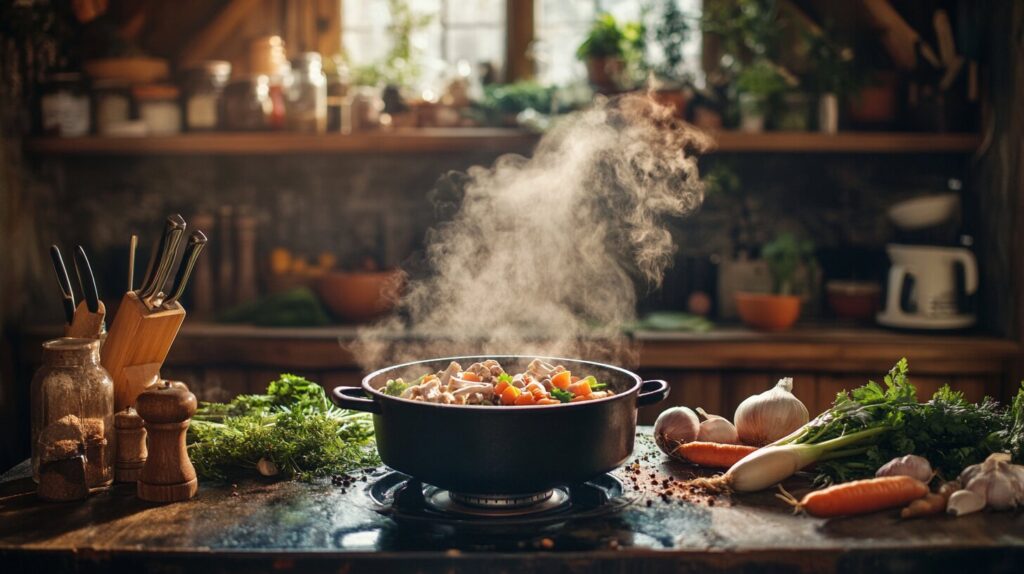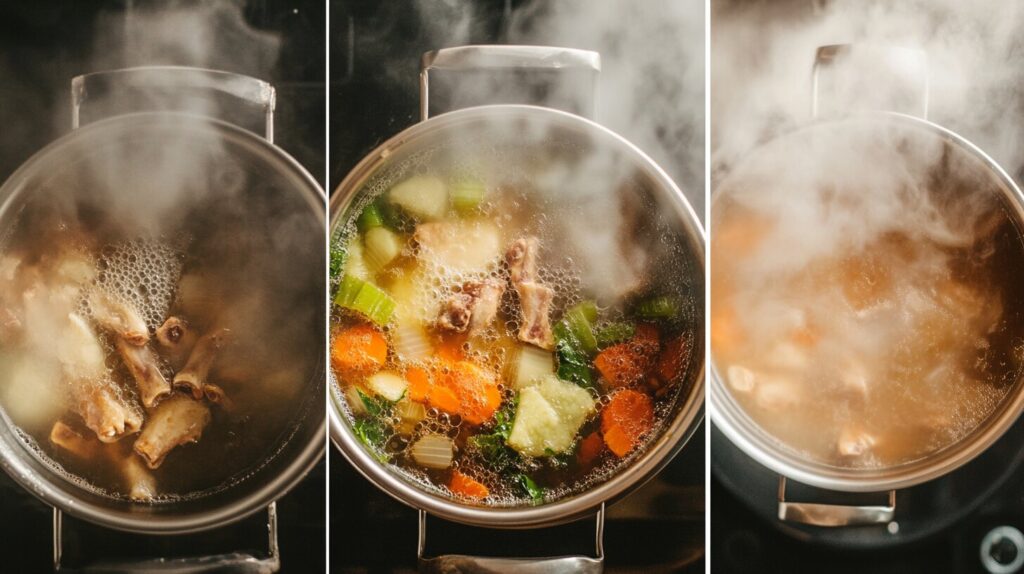
Are soup bones good to eat? This question is common among cooking enthusiasts who appreciate their ability to create rich, flavorful broths and soups. These skeletal treasures, often called “simmering gold,” typically come from cows, pigs, chickens, or fish and are prized for infusing dishes with deep flavor and valuable nutrients. You might hear terms like “marrow bones,” “knuckle bones,” or “neck bones,” each serving a unique purpose in the culinary world.
Soup bones usually contain marrow, tendons, ligaments, and sometimes a bit of meat clinging to them. When cooked slowly, these components break down and release an array of nutrients, creating a liquid that’s both delicious and nutritious.
Fun fact: Bone broths have been a culinary staple for centuries, from ancient Chinese remedies to grandma’s classic chicken soup cure for colds. 🌿
Table of contents
Different Types of Soup Bones and Their Uses
Soup bones come in several varieties, and each offers its own unique benefits. Let’s break down the main types you might encounter:
- Marrow Bones: These are large, thick bones filled with soft, fatty marrow. They’re perfect for creating rich beef broths and stews. The marrow adds a buttery, umami flavor that’s hard to beat.
- Knuckle Bones: Packed with cartilage, these bones are your go-to for making gelatin-rich broths. The collagen from the cartilage breaks down into gelatin, giving your broth that luxurious, silky texture.
- Neck Bones: Often from pigs or cows, neck bones are meaty and perfect for stews. They add a hearty, savory taste and make the broth more filling.
- Fish Bones: If you’re a fan of seafood, fish bones create a light, nutrient-dense broth. The flavor is more delicate compared to beef or pork bones, but it’s just as nutritious.
Tip: To get the most flavor, roast your bones before simmering them. This simple step adds depth and richness to your broth. 🔥
The Nutritional Value of Soup Bones

You might be wondering, “Are soup bones good to eat?” Well, these humble bones are nutrient powerhouses! When you simmer soup bones, they release an array of essential nutrients into the broth. Here are some key nutrients you can get:
- Collagen and Gelatin: These proteins are excellent for your skin, joints, and digestive health.
- Minerals: Soup bones are rich in calcium, magnesium, potassium, and phosphorus—all vital for strong bones and overall health.
- Amino Acids: Essential amino acids like glycine, proline, and glutamine support muscle growth, repair tissues, and boost your immune system.
- Marrow: Bone marrow contains healthy fats, vitamins, and minerals that can give your body a nutrient boost.
“Bone broth is like liquid gold for your health. A few sips a day can support your body in more ways than you think.” ✨
Why Are Soup Bones Good to Eat?
Now, let’s get to the heart of the matter: Are soup bones good to eat? The short answer is that they’re jam-packed with nutrients your body loves. But let’s break it down even further.
H3: Rich in Minerals and Nutrients
When you simmer bones for hours, the minerals inside them leach into the water, creating a nutrient-dense broth. These include:
- Calcium: Essential for strong bones and teeth.
- Magnesium: Helps regulate muscle and nerve function.
- Potassium: Supports heart health and hydration.
- Phosphorus: Works alongside calcium to keep your bones strong.
Drinking a cup of bone broth is like giving your body a mineral boost in the most natural way possible.
Collagen and Gelatin: Health Benefits Explained
Are soup bones good to eat? If you’ve ever chilled bone broth and noticed it turned into a jelly-like substance, that’s gelatin. And guess what? That’s a good thing! Gelatin is broken-down collagen, a protein that helps:
- Keep your skin youthful and elastic.
- Strengthen your joints and reduce pain.
- Support your gut lining for better digestion.
As you age, your body produces less collagen. Consuming bone broth regularly can help replenish this vital protein, keeping you feeling young and spry.
“Think of collagen as the glue that holds your body together. More collagen means fewer aches, wrinkles, and digestive issues.” 💪
H3: How Soup Bones Support Gut Health
Are soup bones good to eat? Absolutely! Your gut is like your body’s command center, affecting everything from your mood to your immune system. If your gut isn’t happy, your body isn’t happy. That’s where soup bones come in.
The gelatin in bone broth helps seal the gut lining. This is particularly beneficial for people suffering from leaky gut syndrome or digestive disorders. Plus, amino acids like glutamine help repair and maintain gut health.
By drinking bone broth, you’re giving your gut the tools it needs to function smoothly.
Are There Any Risks to Eating Soup Bones?
Of course, with all the benefits, you might wonder if there’s a catch. Are there any downsides to consuming soup bones or bone broth? While the risks are minimal, it’s good to be aware of potential pitfalls.
Potential Hazards of Overconsumption
You might wonder, “Are soup bones good to eat?” While they offer many benefits, as with anything, too much of a good thing can turn sour. Overconsuming bone broth might lead to:
- Excess Lead Exposure: Some studies suggest that bones can contain trace amounts of lead. If you consume large quantities of bone broth daily, this could become a concern. To minimize this risk, use high-quality, organic bones.
- High Sodium Levels: Many broths can be high in sodium, especially store-bought versions. If you have high blood pressure, keep an eye on your sodium intake.
Who Should Avoid Soup Bones?
While most people can enjoy the benefits of soup bones, some groups should be cautious:
- People with Histamine Intolerance: Bone broth can be high in histamines, which might trigger reactions in sensitive individuals.
- Individuals with Kidney Issues: Because bone broth is mineral-rich, it can strain the kidneys of people with chronic kidney disease.
If you’re in doubt, it’s always best to consult with your healthcare provider before adding large amounts of bone broth to your diet.
Block Quote for Inspiration:
“Bone broth is not just food; it’s ancient wisdom in a bowl. One sip can nourish your body and soul.” 🥣✨
How to Prepare Soup Bones for Consumption

Preparing soup bones may seem intimidating, but once you understand the basics, it’s a breeze! The goal is to extract as much flavor and nutrition as possible. Whether you’re aiming for a light broth or a rich, hearty stock, the preparation process is key. Let’s explore some simple yet effective techniques to prepare soup bones for your next delicious creation.
Roasting and Boiling Techniques
Roasting your bones before simmering is like adding a turbo-boost of flavor to your broth. This step is optional, but if you love deep, caramelized notes in your broth, you won’t want to skip it.
Here’s how to do it:
- Preheat the oven to 400°F (200°C).
- Spread the bones on a baking sheet in a single layer.
- Roast for 30-45 minutes, turning the bones halfway through to ensure even browning.
- Once they’re beautifully browned and fragrant, transfer them to a pot or slow cooker for simmering.
Boiling (Simmering) Tips:
Once your bones are roasted, it’s time for the slow magic to happen. Here’s a step-by-step guide to boiling soup bones:
- Add the roasted bones to a large pot or slow cooker.
- Cover with water, ensuring the bones are fully submerged.
- Add aromatics like onions, garlic, carrots, celery, and herbs (think bay leaves, thyme, or parsley).
- Add a splash of vinegar (apple cider vinegar works great) to help draw out the minerals and collagen.
- Bring to a boil, then reduce to a low simmer.
- Simmer for 6-24 hours, depending on the type of bones. Beef bones typically need longer, while chicken bones can be done in 6-8 hours.
- Skim off any foam or impurities that rise to the top during the first hour.
- Strain the broth through a fine-mesh sieve and discard the solids.
You’re left with a rich, nourishing broth ready to sip or use in your favorite recipes.
Tip: For extra flavor, add fresh herbs during the last 30 minutes of cooking. 🌿
Tips for Making the Perfect Bone Broth
Getting the perfect bone broth is part art, part science. Follow these tips to ensure your broth turns out delicious and nutrient-dense every time:
- Use a Variety of Bones: Combining marrow bones, knuckle bones, and meaty bones results in a more balanced, flavorful broth.
- Add Acid: A tablespoon or two of apple cider vinegar helps break down the bones, releasing more minerals and nutrients.
- Low and Slow: The key to extracting nutrients is low and slow cooking. Avoid rapid boiling, as it can break down the gelatin and cloud the broth.
- Don’t Forget Salt: Salt enhances the flavor. Add a pinch during the simmering process, but you can always season more at the end.
- Cool and Skim Fat: Once your broth is done, let it cool and skim off the solidified fat for a clearer broth. (Save the fat for cooking—it’s liquid gold! 💛)
- Storage is Key: Store your broth in glass jars or silicone molds for easy portioning. It can be refrigerated for up to 5 days or frozen for several months.
Block Quote:
“Great bone broth isn’t rushed. Patience is the secret ingredient that transforms simple bones into a pot of nourishing goodness.” 🥄
The Difference Between Store-Bought and Homemade Broth
You might wonder, “Why go through the effort of making broth at home when I can just buy it from the store?” It’s a fair question! Let’s compare the two so you can decide what’s best for you.
Comparing Nutritional Content
Homemade broth often outshines store-bought options in both flavor and nutrition. Here’s why:
- Ingredients Control: When making your own broth, you control the quality of the bones, the amount of salt, and the addition of herbs and vegetables.
- No Additives: Store-bought broths often contain preservatives, artificial flavors, and excess sodium. Homemade broth is clean and natural.
- Higher Collagen Content: Many commercial broths lack the gelatinous texture of homemade versions because they’re not simmered long enough to extract collagen.
Tip: If you do buy store-bought broth, opt for organic or grass-fed options with no added preservatives.
Health Benefits of Homemade vs. Processed Broth
Homemade bone broth delivers superior health benefits:
- Better for Gut Health: Homemade broth is rich in gelatin and amino acids that support digestive health.
- Joint Support: Higher collagen levels in homemade broth provide more joint-healing properties.
- Fewer Allergens: You can avoid common allergens or ingredients that don’t sit well with you.
In short, homemade broth is like a warm hug for your body—pure, nourishing, and customizable.
Common Problems with Using Soup Bones
Even though making soup bone broth is simple, a few common problems can crop up. Don’t worry—most of these issues are easy to fix.
Dealing with Unpleasant Odors or Flavors
Sometimes, your broth might smell or taste off. Here’s how to handle it:
- Gamey or Metallic Flavor: This often happens with beef or lamb bones. Roasting the bones before simmering helps reduce this taste.
- Too Bland: If your broth lacks flavor, add more aromatics like garlic, onions, and herbs. Salt also enhances the overall taste.
- Unpleasant Odor: Use fresh bones and avoid simmering for too long, which can give off a stale or burnt smell.
How to Avoid Cloudy Broth
Cloudy broth is more of an aesthetic issue than a taste problem, but if you want clear broth:
- Avoid Rapid Boiling: Keep the heat low and let it simmer gently.
- Skim Regularly: Remove impurities and foam during the first hour of cooking.
- Use a Fine-Mesh Strainer: Strain the broth through cheesecloth or a fine-mesh sieve to catch any solids.
Best Practices for Storing Soup Bones
Storing soup bones correctly ensures they stay fresh and safe for use. Whether you’re freezing raw bones or leftover broth, here’s what you need to know.
Freezing and Refrigerating Techniques
- Raw Bones: Store raw bones in airtight freezer bags. Label and date them—they’ll keep for up to 6 months in the freezer.
- Broth: Pour cooled broth into mason jars, silicone molds, or freezer-safe containers. Leave space at the top to allow for expansion.
How Long Do Soup Bones Stay Fresh?
- Refrigerator: Raw soup bones can be kept in the fridge for up to 3-5 days.
- Freezer: Properly stored raw bones can last up to 6 months.
- Broth: Homemade broth stays fresh in the fridge for up to 5 days and in the freezer for up to 3-4 months.
How to Incorporate Soup Bones into Your Diet
Adding soup bones and bone broth to your diet doesn’t have to be boring or repetitive. Are soup bones good to eat? Absolutely! In fact, there are so many creative ways to enjoy the benefits of these nutrient-rich powerhouses. Whether you’re sipping it straight or using it as a secret ingredient, bone broth can bring warmth and nourishment to a variety of dishes.
Creative Recipes Using Soup Bones
Ready to transform those bones into mouthwatering meals? Here are some exciting and versatile recipes that’ll have you making the most of your soup bones.
🍲 Classic Beef Bone Broth
Ingredients:
- 2-3 pounds beef soup bones (marrow, knuckle, or neck bones)
- 2 carrots, chopped
- 2 celery stalks, chopped
- 1 onion, quartered
- 3 cloves garlic, smashed
- 2 tablespoons apple cider vinegar
- Fresh herbs (bay leaf, thyme, parsley)
- Salt and pepper to taste
Instructions:
- Roast the bones in the oven at 400°F (200°C) for 45 minutes.
- Place bones in a large pot, add chopped vegetables, and cover with water.
- Add apple cider vinegar and bring to a boil.
- Lower heat and simmer for 12-24 hours. Skim impurities as needed.
- Add herbs in the last 30 minutes of simmering.
- Strain and season with salt and pepper.
Sip this warm broth on cold days, or use it as a base for soups, stews, and sauces. 🥣
🍜 Hearty Chicken Bone Broth Soup
Perfect for sick days or cozy evenings, this chicken bone broth soup is both comforting and healing.
Ingredients:
- 2 pounds chicken bones (carcass, wings, or drumsticks)
- 2 carrots, sliced
- 2 celery stalks, chopped
- 1 onion, diced
- 2 cloves garlic, minced
- Fresh parsley and thyme
- Salt and pepper
Instructions:
- Simmer chicken bones, vegetables, and herbs in a pot of water for 6-8 hours.
- Strain the broth and season to taste.
- Add cooked chicken, noodles, or rice for a heartier meal.
This soup is a hug in a bowl! 🥰
🥘 Vegetable and Beef Stew with Bone Broth
Amp up your stews by replacing water or store-bought broth with homemade bone broth. This adds a rich, deep flavor and a nutritional boost.
Ingredients:
- 2 pounds beef stew meat, cubed
- 4 cups beef bone broth
- 3 potatoes, diced
- 2 carrots, sliced
- 1 cup peas
- 2 tablespoons tomato paste
- 1 onion, chopped
- Herbs (rosemary, thyme, bay leaf)
Instructions:
- Brown the beef in a large pot.
- Add onion and tomato paste, cooking until fragrant.
- Pour in bone broth and bring to a simmer.
- Add vegetables and herbs, and cook until everything is tender.
Serve with crusty bread for the ultimate comfort meal! 🍞
Vegan and Vegetarian Alternatives for Bone Broth
Not a meat-eater? No problem! While traditional bone broth is made from animal bones, you can still enjoy the benefits of a nutrient-rich broth with plant-based ingredients.
Nutrient-Rich Vegetable Broth
Ingredients:
- 2 carrots, chopped
- 2 celery stalks, chopped
- 1 onion, quartered
- 2 cloves garlic, smashed
- 1 cup mushrooms (for umami flavor)
- Seaweed (like kombu) for minerals
- Fresh herbs (parsley, thyme, bay leaf)
- Salt and pepper
Instructions:
- Sauté the vegetables until fragrant.
- Add water, seaweed, and herbs.
- Simmer for 1-2 hours.
- Strain and season to taste.
This broth is packed with vitamins, minerals, and flavor! It’s a fantastic alternative for soups, stews, and risottos. 🌱
Frequently Asked Questions About Soup Bones
Can You Eat the Bones Themselves?
While bones themselves are too hard to eat, the marrow inside is perfectly edible and highly nutritious. You can scoop out the marrow after roasting and spread it on toast, or mix it into soups for added richness.
How Often Should You Consume Bone Broth?
For most people, drinking bone broth 3-4 times a week is ideal. If you’re addressing specific health issues, like joint pain or gut problems, daily consumption can be beneficial.
Does Bone Broth Help with Weight Loss?
Yes! Bone broth is low in calories but high in protein, which helps you feel full. It’s a great addition to a balanced diet for weight management.
Can You Reuse Soup Bones?
Yes! After making your first batch of broth, you can reuse the bones for a second (and even third) batch. The flavor may weaken, but you’ll still extract some nutrients.
Why Does My Bone Broth Gel When It Cools?
That’s a good thing! The gel-like consistency means your broth is rich in collagen and gelatin, which are excellent for your joints, skin, and gut health.
Is Bone Broth Safe During Pregnancy?
Absolutely. Bone broth is a great source of nutrients during pregnancy. Just ensure you’re using high-quality bones and avoid excessive sodium.
Explore More Delicious Recipes and Tips!
If you enjoyed learning about soup bones and their incredible benefits, you’ll love diving into more of our guides and recipes. Here are some hand-picked articles to enhance your cooking journey:
- Everything You Need to Know About Soup Bones – Get a comprehensive breakdown of soup bones, their uses, and nutritional value.
- The Ultimate Guide to Beef Tips Recipes – Discover how to prepare tender, flavorful beef tips with this complete guide.
- Stew Meat vs. Beef Tips: Differences, Uses, and Best Recipes – Learn the differences between stew meat and beef tips and how to use them in your cooking.
- What Are the Best Bones for Soup? – Find out which bones will give you the most flavorful and nutrient-rich broths.
Keep exploring, keep cooking, and enjoy the rich flavors and health benefits of homemade dishes! 🍲✨
Final Thoughts: Are Soup Bones Worth Adding to Your Diet?
So, are soup bones good to eat? The answer is a resounding yes! They’re a simple, cost-effective way to boost your nutrition, enhance your meals, and support your overall health. Whether you’re looking to improve joint health, boost your gut, or simply enjoy a comforting bowl of broth, soup bones are a time-honored ingredient that deserves a spot in your kitchen.
Adding bone broth to your routine is like investing in your body’s future. It’s a small habit that brings big benefits. So, grab some soup bones, start simmering, and enjoy the nourishing goodness you’ve been missing! 🍲✨
